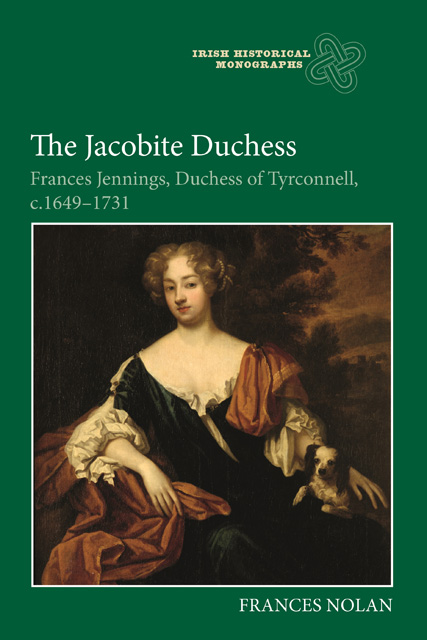Book contents
- Frontmatter
- Dedication
- Contents
- List of illustrations
- Acknowledgements
- List of abbreviations
- Notes on the text
- Introduction
- 1 ‘The malicious little gipsy’: Early life, c.1649–65
- 2 ‘Hambleton is now going into France’: Marriage, motherhood and migration, 1666–76
- 3 ‘Ruined beyond redemption’?: Widowhood, remarriage and returning, 1676–86
- 4 ‘That caballing humour’: A political woman, 1687–90
- 5 ‘Every one’s eye is watching’: Treason, forfeiture and exile, 1691–99
- 6 ‘Always a plane dealor’: Changing fortunes and life in the Low Countries, 1700–08
- 7 ‘A duchess-nun’?: Family, faith and finance in old age, 1708–30
- 8 ‘Albion’s fairest plant’: Death and legacy, 1731
- Appendix A: Duchess of Tyrconnell’s family tree
- Appendix B: Books in the possession of the duchess of Tyrconnell in Dublin, transported from her apartment in the Château de Saint-Germain-en-Laye
- Appendix C: David Nairne’s ‘Cyffer w[i]th the D[uche]sse of Tyrconnel, 5th August 1702’
- Bibliography
- Index
- Irish Historical Monographs previous volumes
1 - ‘The malicious little gipsy’: Early life, c.1649–65
Published online by Cambridge University Press: 04 January 2024
- Frontmatter
- Dedication
- Contents
- List of illustrations
- Acknowledgements
- List of abbreviations
- Notes on the text
- Introduction
- 1 ‘The malicious little gipsy’: Early life, c.1649–65
- 2 ‘Hambleton is now going into France’: Marriage, motherhood and migration, 1666–76
- 3 ‘Ruined beyond redemption’?: Widowhood, remarriage and returning, 1676–86
- 4 ‘That caballing humour’: A political woman, 1687–90
- 5 ‘Every one’s eye is watching’: Treason, forfeiture and exile, 1691–99
- 6 ‘Always a plane dealor’: Changing fortunes and life in the Low Countries, 1700–08
- 7 ‘A duchess-nun’?: Family, faith and finance in old age, 1708–30
- 8 ‘Albion’s fairest plant’: Death and legacy, 1731
- Appendix A: Duchess of Tyrconnell’s family tree
- Appendix B: Books in the possession of the duchess of Tyrconnell in Dublin, transported from her apartment in the Château de Saint-Germain-en-Laye
- Appendix C: David Nairne’s ‘Cyffer w[i]th the D[uche]sse of Tyrconnel, 5th August 1702’
- Bibliography
- Index
- Irish Historical Monographs previous volumes
Summary
There is no record of Frances Jennings birth or baptism, but she was born sometime in 1648 or 1649, in the shadow of the Civil War and the execution of Charles I. She was the third of nine children, five of whom would survive infancy, born to Richard and Frances Jennings of St Albans in Hertfordshire. Richard Jennings was the eldest son of a minor gentry family who owned the manor of Holywell House in St Albans, as well as property in Somerset and Surrey. He was admitted to the Inner Temple in 1634, long before he turned his thoughts to marriage and fatherhood, and then passed three years in Italy, before returning to England in 1640. Two years later, he succeeded his father as MP for St Albans. In London in December 1643, Richard married the 18-year-old Frances Thornhurst, an heiress who was six years his junior. The young woman represented a good match; her father, Sir Gifford Thorhnhurst, had died when she was still an infant and she had inherited a lease of lives on the manor of Agney in Old Romney, Kent. Her mother, Susanna, was a member of the Temple family of Sussex and older half-sister of the regicide, James Temple, and served as a maid of honour to Anne of Denmark at the court of James I before her first marriage. Susanna was still a young woman when widowed in 1627 and remarried to Sir Martin Lister of Thorpe Arnold in Leicestershire in 1636. This marriage produced a number of children, among them a son who would become the celebrated physician and naturalist, Dr Martin Lister.
The Jennnings’ first daughter, Susanna, was born in Westminster in February 1645, and was followed into the world by a son, John, who was born in Sir Martin and Susanna Lister’s home in Thorpe Arnold and baptised in the village church in October 1647. Frances came next, but the date of her birth can only be approximated as taking place between the summer of 1648 and the end of 1649. No baptismal record exists for the Jennings’s next child, Barbara, either, but it can be said with some certainty that she was born in 1651, as she was described as being ‘ab[ou]t 22’ at the time of her marriage in 1673.
- Type
- Chapter
- Information
- The Jacobite DuchessFrances Jennings, Duchess of Tyrconnell, c.1649-1731, pp. 20 - 36Publisher: Boydell & BrewerPrint publication year: 2021

